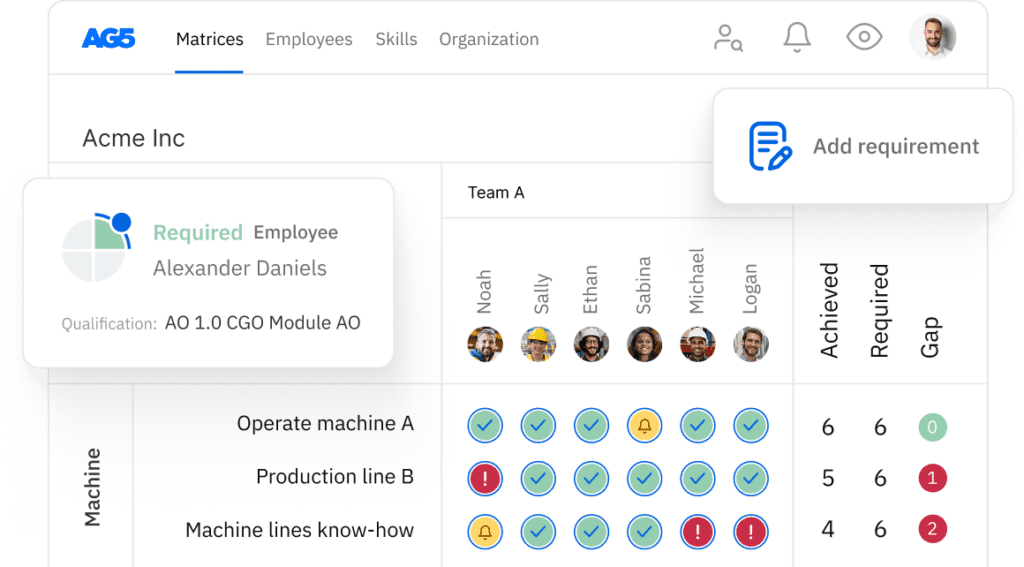Why skills-based hiring for deskless workers sets your organization up for success
What exactly is skills-based hiring? We’ll take a look at the strategy, methods for its implementation, and examine a few of its benefits in detail.

According to TestGorilla’s “The State of Skills-Based Hiring 2022” report [1],
“76% of employers use some skills-based hiring to find new talent, with almost 55% using role-specific skills tests.”
This should come as no surprise, especially to organizations that rely on highly skilled or specialized employees – such as deskless or frontline workers – to keep operations running. By implementing and leveraging skills-based hiring strategies, these organizations are able to reduce bias, find and retain higher-quality candidates, and strategically close skills gaps along the way.
So what is skills-based hiring? Let’s find out! In this article, we’ll take a look at the strategy, methods for its implementation, and examine a few of its benefits in detail.
Copied
What is skills-based hiring?Copied
Skills-based hiring is an approach to recruitment and talent acquisition that focuses on assessing and selecting candidates for roles based on their specific skills, abilities, and competencies rather than solely relying on traditional qualifications, such as degrees or years of experience.
How can you implement skill-based hiring?Copied
When organizations implement skill-based hiring processes, they must almost always first conduct a skills gap analysis to determine the skills that are present in the organization, as well as those they need – which are also the skills or qualifications that successful job candidates will possess.
From there, managers or HR leaders can create skill profiles for job candidates, which they can use to create job listings. In the interview stage, candidates will be assessed in structured interviews and objective, skills-based assessments.
The top benefits of skills-based hiringCopied
In this section, we’ll take a look at several of the major benefits skills-based hiring brings to organizations, allowing them to work and hire more quickly and productively, and with employees who stay in their roles for longer periods of time.
Better-quality candidates, faster
By focusing on candidates’ specific qualifications, rather than education or experience, organizations can better ensure they meet job requirements. This objective approach reduces biases and identifies individuals with the necessary skills, leading to better-quality hires more quickly.
TestGorilla’s report backs this claim, with 92.5% of companies that use skills-based reporting having “seen a reduction in their mis-hire rate, with 44% reporting a decrease of more than 25%.” Additionally, 91% reported faster time-to hire, 39.9% of which noted a decrease of more than 25%.
Decreased hiring costs
By focusing on specific skills and competencies rather than traditional qualifications, organizations can streamline their recruitment processes. This reduces the need for extensive candidate screening, minimizes the risk of hiring mismatches (which is touched on above), and ultimately lowers recruitment expenses associated with advertising, interviewing, and onboarding.
“Additionally, candidates hired based on their skills require less training, as they already possess the necessary competencies to perform the job effectively,” reads a LinkedIn article on the power of skills-based hiring. [2] “This streamlined onboarding process saves both time and money for organizations, allowing them to allocate resources more efficiently.” [5]
Increased retention rates
Because skills-based hiring eliminates bias and places focus on skills and qualifications rather than education or experience, organizations are more likely to consider candidates without degrees or diplomas. These candidates, according to a Harvard Business Review article [3],
“stay at companies 34% longer than those with such a degree.”
Hiring a non-degreed candidate over a degreed candidate may also be taken as a sign of a business’s confidence in employees, inspiring loyalty – and thus sparking increased retention rates, with LinkedIn’s “2018 Workplace Learning Report” [4] revealing that “94% of employees said they would stay at a company longer if it invested in their career.”
Improved job performance
“Hiring for skills is five times more predictive of job performance than hiring for education and more than two times more predictive than hiring for work experience,” writes McKinsey, in an article about skills-based hiring [6].
This assertion’s truth hinges on the idea that skills reflect practical, up-to-date abilities – and rings especially true for industries and organizations in which technologies, processes, or other ways of working are prone to rapid or continuous change.
How AG5 supports skills-based hiringCopied
AG5’s skills management platform aligns with skill-based hiring initiatives by enabling managers and business leaders to easily conduct skills analyses to identify skills gaps, then use that information to develop targeted, skills-based hiring strategies.
With AG5, you can:
- Quickly and easily conduct skills analyses
- Use that information to identify skills gaps
- Develop skills-based hiring strategies, so you can find the employees your organization needs to the most
- Place a focus on continuous improvement with an easy-to-understand interface that your employees can use to quickly and easily ensure they are compliant, safe, and ready to work
- Work with employees to determine the career paths that match their and your organization’s interests
- And much more!
Ready to discover AG5? Schedule a free, 15-minute live demo today to see how AG5’s skills management software can transform the way you and your deskless workers operate.
Sources Copied
- Change view: Table
-
APA
| # | Source title | Description | Publication | Retrieved | Source URL |
|---|---|---|---|---|---|
| 1 | THE STATE OF SKILLS-BASED HIRING 2022 | Test Gorilla | - | May 1, 2024 | https://www.testgorilla.com/st.. |
| 2 | Job Seekers, LinkedIn Will Guarantee Your Next Interview—If You Can Pass A Test | Forbes | - | May 1, 2024 | https://www.forbes.com/sites/k.. |
| 3 | You Need a Skills-Based Approach to Hiring and Developing Talent | HBR | - | May 1, 2024 | https://hbr.org/2021/06/you-ne.. |
| 4 | Workplace Learning Report 2018 | - | May 1, 2024 | https://learning.linkedin.com/.. | |
| 5 | The Power of Skills-Based Hiring - Finding the Perfect Match for Your Organization. | - | May 1, 2024 | https://www.linkedin.com/pulse.. | |
| 6 | Taking a skills-based approach to building the future workforce | McKinsey | - | May 1, 2024 | https://www.mckinsey.com/capab.. |
Author Copied
Revisions Copied
Sources checked and new format added.
Written by: Rick van Echtelt
Copy edited by: Adam Kohut

